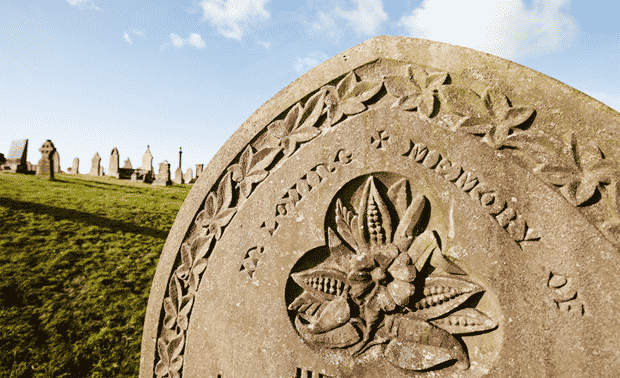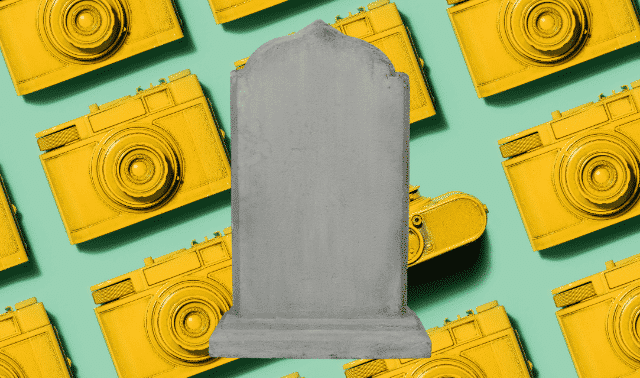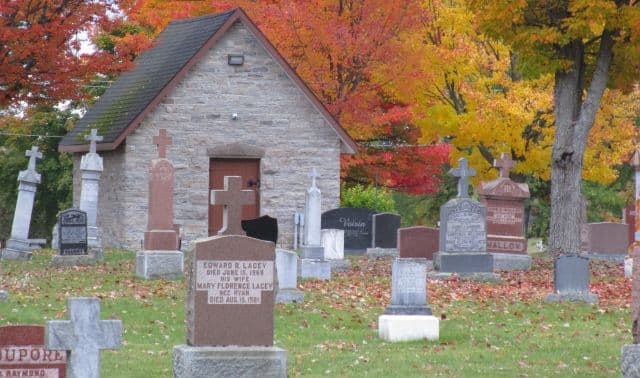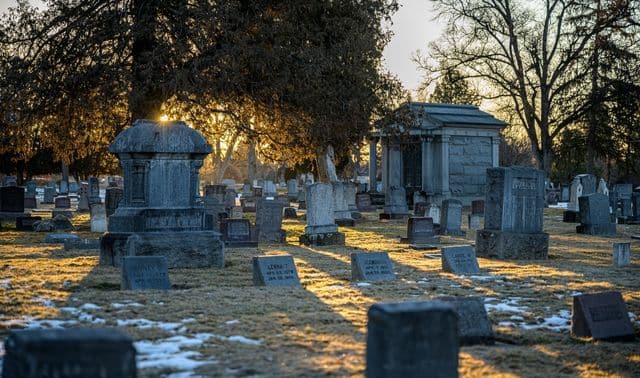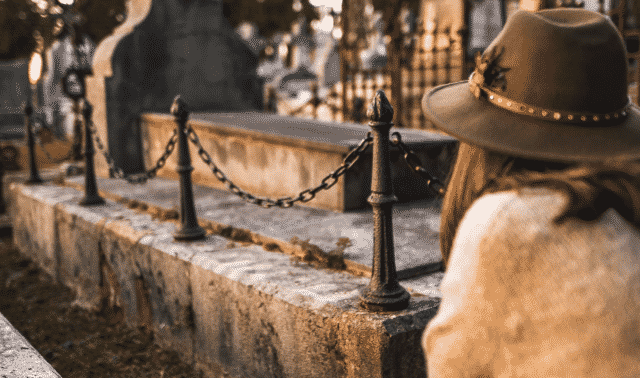
In this article:
Finding the final resting place
Planning your cemetery field trip
Cemetery visits: A good way to find living relatives
How can you tell a genealogist from someone who’s not interested in family history? The genealogist is the one who subconsciously turns her head and slows down when driving by a cemetery. We just can’t help it. On a cross-country trip, some people can tell what direction they’re going by where the sun is. I can tell by looking at a cemetery (I’ll explain how later).
Police officers have eyed me warily because I spend a lot of time hanging out in cemeteries, wearing jeans and a black T-shirt emblazoned with a bright, white skull with wings. Though the police may be skeptical, gang members adore me and have offered me honorary membership. I’m actually wearing a 17th-century winged death’s head, a popular piece of art carved on gravestones back then. But I just know that one of these days I’m going to be “hauled downtown” for questioning.
It’s worth the risk, though. At cemeteries, you can be close to your ancestors both physically and spiritually. Although it’s always a thrill to find their names in historical documents, nothing can beat uncovering their tombstones and knowing that they lie just 6 feet below you. You’re treading on the same ground they once walked, seeing the same headstones they looked at before they died — those of their friends, neighbors and family members. Here you have physical evidence that your ancestors existed.
But there’s much more to visiting your ancestors’ grave sites than meets the eye. And, of course, first you have to find them.
Finding the final resting place in a cemetery
Searched all the cemetery websites and still coming up short?
If your ancestor died within the last century, you easily can learn where he’s buried through funeral cards, death certificates or obituaries. If these home sources don’t include his burial place, but they do list a funeral home, check the International Blue Book of Funeral Service (Kates-Boylston Publications) for contact information — you’ll find this book in most libraries’ reference sections. If the funeral home no longer exists, contact the local or state historical society or public library to find our what happened to the records.
Discovering an older ancestor’s grave site may require more creativity. You’ll first need to find out where the person died, since that’s probably where he’s buried. Then, before actually going to the graveyard, you might look for a published cemetery transcription. Genealogists have transcribed information about cemeteries all over the world. A good place to start your search is the Family History Library’s online catalog. I suggest searching on the locality and the word cemetery (such as “san francisco” cemetery). More cemetery and tombstone registries are popping up on the Internet, too, so you can swap data with other researchers.
You also might try published family histories. An earlier genealogist may have located the grave and recorded its whereabouts in one of these tomes. If you know your ancestor’s religious affiliation, try contacting the churches in the area. To see if cemetery records exist, write directly to the cemetery sexton (if the cemetery is still active) or to the town ball or county courthouse where the cemetery is located.
Also try the US Geological Survey’s Geographic Names Information System. Type in the locality and select “cemetery” from the Feature Type pull-down menu, and you’ll get a list of cemeteries in that area.
Finding the right cemetery depends in part on what kind it is. Cemeteries fall into at least eight categories, according to Kenneth Jackson and Camilo Vergara’s Silent Cities: The Evolution of the American Cemetery (Princeton Architectural Press).
8 categories of cemeteries
Understanding these different types of cemeteries may help you narrow down your ancestor’s final resting place.
1. Church graveyards
These were our country’s first cemeteries. In Europe, the elite were buried inside the church, under the stone floor. This wasn’t as feasible in America because most churches were so much smaller. But in large cities with cathedrals, under-the-floor burial was popular for the elite. Everyone else was buried outside.
2. Family burial plots
Located on private property, these burial grounds may be difficult to locate if they haven’t been maintained and aren’t well-known in the community. Many genealogical societies have cemetery committees, which not only transcribe tombstones in local cemeteries, but also attempt to locate and document family burial grounds, Check with the local genealogical society for hard-to-find grave sites, and look for your ancestral county’s USGenWeb site (click on The Project’s State Pages, then follow the links) for contacts and possibly lists of family plots in the area.
3. Country cemeteries
These are the cemeteries you see as you drive down the “blue highways” of America. They often contain homemade or mail-order markers.
4. Elite garden cemeteries
The garden cemetery began in the early 19th century; Mount Auburn Cemetery in Cambridge, Mass., was the first of its kind. These park like cemeteries contain paths, ponds, trees, foliage and benches. Before we had public parks, people visited these cemeteries on Sunday afternoons to picnic, contemplate and take afternoon strolls.
5. Ordinary urban cemeteries
These are just rows and rows of tombstones, with straight paths and little foliage.
6. Veterans cemeteries
The United States has 120 national veterans cemeteries for the honorably discharged and their families — go to gravelocator.cem.va.gov to locate an ancestor buried in one of these graveyards, or write to the Department of Veterans Affairs, National Cemetery Administration (41C1), Burial Location Request, 810 Vermont Ave. NW, Washington, DC 20420. Include the ancestor’s full name, dates and places of birth and death, the state from which he or she entered active duty, and the military service branch.
7. Memorial parks
These flat, grassy lawns show few signs that people actually are buried there. The tombstones are flat and flush with the ground; they contain the name of the deceased and usually just a birth and death year.
8. Potter’s fields
Counties and cities bury their poor, unknown and unwanted in these cemeteries. If your ancestor fell into one of those categories, you’re probably out of luck.
Planning your cemetery field trip
After locating your ancestral burial grounds, you’ll want to visit them. The best time of year for a trip to the cemetery is early spring. The weeds shouldn’t be overgrown, and the snow and winter rain may have cleaned off the tombstones. Cemeteries are wonderful places to get chiggers, ticks, bug bites and poison ivy rashes, so wear protective clothing and boots, and carry bug repellent.
Watch for uneven ground, since graves tend to sink. When my daughter, Laurie, was 3 or 4, we went cemetery hopping. Laurie was walking behind me, when suddenly I heard her call out. She’d fallen into a sunken grave. (She was OK, and her therapist says she still has a good chance of leading a normal life.)
Don’t just rush to find your ancestor’s grave, photograph the tombstone, then leave. Look around you. This is your forebear’s final resting place. Remember: You’ll never be closer to your ancestor than at this moment. What does the cemetery look like? Take a few pictures of the grounds and of the gateway into the graveyard.
Here are some other items to note:
- Who’s buried around your ancestor? They could be relatives.
- Where is the grave located in relation to the entrance? Jot this down, so you can find it again and tell others how to get there.
- Does the cemetery offer a map with sections and plot numbers? If so, mark the grave’s location, and keep the map with your family history files.
Analyzing the headstone
Now let’s concentrate on the tombstone. What kind of stone is it? Though parts of the inscription may be weathered and unreadable, or it may have sunk into the ground so you can’t read the death date, you still can get an idea of when the stone was placed by noticing its composition. If it’s granite and the death date is, say, 1789, you know it’s not the original stone — granite wasn’t used until the 1880s.
Here’s a quick history lesson in tombstone composition:
- Pre-1650s: Grave markers were uncarved, rough-cut boulders.
- 1660s to 1850s: Tombstones were made from sedimentary rock, such as sandstone and limestone.
- Late 1700s to 1880s: Marble was popular. This rock is especially prone to weathering and dissolves easily in acid (acid rain is a real enemy to marble tombstones). In the 1930s, the Works Progress Administration revived the use of marble for veterans’ markers.
- 1880s to 1910s: Soft, gray granite and cast-metal markers were first used.
- 1920s to present: Granite is the most popular material.
Note the artwork on the stone, as well, These symbols weren’t chosen randomly — they have special meanings.
Also be aware that stonecutters make mistakes. Just because a name or date is carved in stone, that doesn’t mean it’s accurate. Mistakes are costly to correct, so if the carver accidentally made your great-grandmother many years younger than she actually was, that’s what the tombstone would tell posterity.
Taking tombstone photographs
Next, you’ll want to take a photograph of your tombstone find. You’ll need:
- camera and film
- spray bottle filled with water
- plastic or nylon brush (never wire)
- rags
- mirror (preferably a full-length one)
Before you snap a picture, the stone may need some light cleaning. Lichen and moss love to attach themselves to tombstones, and birds find them irresistible to perch and poop on, making the inscription harder to read and unattractive to photograph. Spray the stone with water only, lightly use a nylon or plastic brush to loosen the debris, then gently rub with your rag. Keep in mind that tombstones are historical artifacts; some have been around since the 1600s. Just because it’s made from stone doesn’t mean it’s durable. Some stones already may be crumbling — in that case, do not do anything to the stone!
Acidic compounds, such as vinegar, can eat away at marble. Many genealogists (myself included) used to use shaving cream to clean stones and better bring out their images, but gravestone preservationists now caution that shaving cream also is acidic. Chalk is another method we used to recommend, but don’t anymore because it can leave a residue on porous stones. Stick with plain water; sometimes just wetting a stone can help bring out the inscription.
Photographs turn out better if you take them in early morning light. In many cemeteries, graves lie on an east-west axis (which is how I’m able to use cemeteries to tell what direction I’m traveling). That puts some inscriptions on the western sides of stones. If you wait until late afternoon to take a picture, the sun will be behind you, and you’ll cast a shadow over the inscription. The reflection from a mirror can help light up the stone for a better photograph, but you’ll need to bring along an assistant to hold the mirror.
Even if you photograph your finds, it’s still wise to make a written record of the inscription, You also can try a tombstone rubbing (see opposite page). Sometimes your photos won’t turn out — or worse, as a friend of mine discovered after taking a whole roll, the camera might not have film in it.
Cemetery visits: A good way to find living relatives
If you thought you’d find only your deceased ancestors in the cemetery, think again. Visiting the graveyard around Memorial Day or a town’s decoration day, you could find living relatives, as well. If you can’t visit on one of those days, leave a note or ask someone in the area to do it for you.
Professional genealogist Marcia K. Wyett once left a note that said she was interested in contacting the relatives of someone buried in a particular plot, and gave her name and phone number. She addressed the envelope to “The Relatives of ….” She put the envelope in a small plastic bag, bought an inexpensive plant to leave at the grave and attached the plastic bag to the plant. It worked like a charm: After Memorial Day, she got a call from a relative of the deceased.
Picnicking in the cemetery
Most people visit cemeteries on only three occasions: to attend funerals, to pay their respects to loved ones, and to be buried themselves. And that seems to be enough — for most people. Family historians, though, regard cemeteries as big outdoor research libraries. We even picnic in them. When my daughter was a toddler, we went on several graveyard outings.
“Oh, look, Mommy,” I remember her saying, pointing to a group of people nearby. “They’re having a picnic, too.”
“No, Laurie. They’re having a funeral.”
Certainly, you don’t want to interfere with someone’s last big shebang, so you’ll want to move your picnic basket to someplace unobtrusive.
But picnicking in cemeteries isn’t morbid, and it’s certainly not new. The elite garden cemetery was designed to be appealing for Sunday strolls and picnics, so you’re actually carrying on an old tradition. Besides, you can’t help it — any more than you can drive by a cemetery without gawking.
Versions of this article appeared in the October 2000 issue of Family Tree Magazine and the September 2004 issue of Trace Your Family History.

